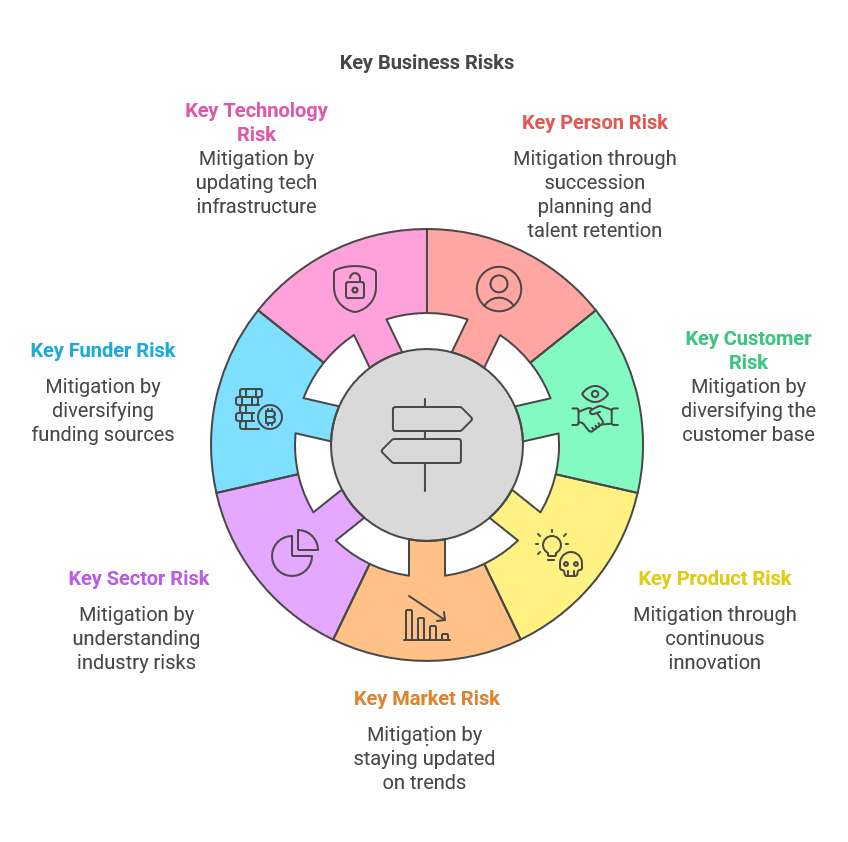Every business operates on risk, whether it is a coffee operations business, a family business, a solopreneur side hustle, or an LLC. What makes one business more successful than the other is how the CEO or Founder understands the risks associated with his kind of business, identifies and manages those risks to the benefit of all stakeholders
Many Nigerian start-ups only plan for success and not the risks. This is one major reason why 70% of Nigerian start-ups fail. Understanding, planning, and managing key business risks is as critical as understanding the revenue side of things because one overlooked, poorly understood, or poorly managed risk could cost you everything you have built. Great leaders do not just plan for success; they prepare for the risks side of things as well
In a recent report by Nairametrics, VC partners stated that many Nigerian E-Commerce giants and Fintech startups are either struggling or failing because of poor due diligence and rushed investment decisions. Simply put, all the key business risks associated with those investments were not properly analyzed by CEOs, Founders, Owners, and Financiers of those businesses before making critical decisions to invest
In this article, we will take a comprehensive look into the Key Business Risks that every Nigerian CEO, Founder, and Entrepreneur must know and how to address each risk. The goal of this post is to arm business owners and leaders with the knowledge and tools to identify and adequately manage key business risks to ensure the success of the enterprises
Some types of risk that will be discussed include key employee risk, key person risk, key customer risk, key product risk, key market risk, and key funder risk among others
Understanding and effectively managing these key business risks will ensure that your company is not part of the ugly statistics above

Why Understanding and Managing Risk Matters
As a CEO or founder, you are responsible for leading your organization through an ever-changing landscape of risks, challenges, and opportunities. While vision and strategy are vital, sound understanding and management of risks are equally critical to your organization’s survival and growth.
Understanding and managing risks is crucial for informed decision-making, ensuring resilience, and achieving objectives.
What is Risk?
Risk is the possibility of the occurrence of an event or incident that could lead to adverse effects on an individual, organization, or system.
It involves exposure to uncertainty and the possibility of loss, damage, or harm.
Risks can arise from internal or external factors and are inherent in nearly all activities and decisions of every organization
Key Components of Risk
- Uncertainty: This is the core thrust of risk. No one ever knows if and when an ugly event will occur. The occurrence or outcome of a risk event is not guaranteed, and there is ambiguity about whether the event will occur or not
- Potential Impact: The possible impact of any risk event could cut across different cost points or centers of the organization. For example, the occurrence of one risk incident may result in financial, reputational, operational, or physical harm.
- Probability: This is the likelihood or chance that a risk may or may not occur. It ranges from low to high.
- Mitigation: These refer to actions that can be taken to reduce, avoid, or control the likelihood and impact of risk events
Some Important Facts to Know About Risk
- Risks are ubiquitous, and they affect all businesses
- Risk characteristics, features, and landscapes are dynamic and ever-changing
- Not all risks are known and covered by organizational policies, so organizations must build adaptability into policies to handle systemic and market risks
- The size and market positioning of your organization determine how risk affects your organization against that of your competitors e.g. if you are the market leader
- Risks are mainly strategic and operational. All other forms fall into these 2 broad categories
Key Business Risks: What Every Nigerian CEO, Founder, and Entrepreneur Should Know and How to Address Each
Key Person or Employee Risk

A Key Person or Key Employee is an individual in an organization whose skills, knowledge, decision-making abilities, or relationships are critical to the success and continuity of the entity. The loss or unavailability of a key person could significantly impact the organization’s operations, profitability, or growth potential.
A Key employee holds a key role in the company on account of his skills, experience, qualities, or position. His role is integral to the company’s success and losing this individual would create a significant void that could negatively affect operations, client relationships, strategic goals, and the fortunes of the business
Examples of Key Employees include: The Founder, Co-Founder, or CEO in startups or small businesses, a lead engineer with domain-specific technical expertise. a top salesperson who contributes significantly to revenue, the operations manager who oversees critical daily functions, and A chief technology officer (CTO) responsible for driving innovation and IT strategy.
Characteristics of a Key Employee
Expertise or Unique Skill Set: They possess specialized knowledge or abilities that are difficult to replicate or replace.
Decision-Making Authority: They hold a critical role in making strategic or operational decisions.
Customer Relationships: They maintain strong, trust-based relationships with important clients or stakeholders.
Leadership Role: They are pivotal in guiding teams or influencing the company\u2019s culture.
Innovation and Creativity: They contribute significantly to the company’s innovation or development of new products and services.
Revenue Generation: They directly impact the company’s financial performance, such as top salespeople or business development leads
Why Key Employee Risk Matters
Key employees often hold critical institutional assets like knowledge, customer relationships, and technical expertise. Losing such talent can disrupt operations, delay projects, and impact morale.
The Risks Associated with Key Employee
• Dependency: Over-reliance on a single employee or small group creates vulnerabilities, weaknesses and compromises in your system. Segregation of duties and transaction cut-off are critical to sustained success
• Transition Gaps: Lack of succession planning can lead to chaos if key employees leave unexpectedly. This could slow down operations
• Knowledge Drain: Departing employees may take valuable proprietary knowledge or relationships with them.
How to Mitigate Key Employee Risk
Succession Planning: Develop clear plans to identify and groom potential successors for critical roles.
Knowledge Sharing: Encourage documentation and cross-function training to prevent institutional knowledge from being concentrated in a particular person
Retention Strategies: Offer competitive benefits, career growth opportunities, and a positive workplace culture.
Insurance Coverage: Consider key person insurance to provide financial stability in the event of a sudden loss.
Team Redundancy: Create overlapping skill sets within teams to minimize dependency on one individual
Build a Strong Leadership Team: Avoid concentrating decision-making power on a single individual; cultivate a team capable of assuming responsibilities.
Diversify Relationships: Ensure multiple people manage critical relationships with clients, partners, and investors.
Operational Systems: Establish robust processes and documentation to minimize reliance on individual expertise.
Key Customer Risk

A Key Customer is a client or customer who contributes the highest to the success of the company in revenue, profit, business volume, or value. They are often characterized by their significant contribution to sales, profitability, or strategic value. Losing a key customer can have a substantial impact on the organization’s financial health and operations.
In Key Accounts Management, Key Customers are usually identified when an organization performs Customer Costs and Profitability Analyses
What is Key Customer Risk?
Key Customer Risk refers to the potential vulnerability a business faces when a significant portion of its revenue or operational stability depends on one or a few major customers.
If the key customer reduces their spending, switches to a competitor, or terminates their relationship with the company, it could lead to financial instability, operational challenges, or even business failure.
Key customer risk shows the danger of “putting all your eggs in one basket.”
By diversifying their client base and proactively managing relationships, businesses can safeguard themselves against customer dependency disruptions and ensure long-term sustainability
Why Key Customer Risk Matters
Many businesses rely heavily on a few major customers for the majority of their revenue. This dependence creates significant risk if one of these customers reduces their orders, renegotiates terms, or exits entirely.
Over-reliance on a single or limited number of customers can create a precarious situation for businesses.
Key customer risk often impacts small to medium-sized enterprises but can also pose a threat to larger companies operating in niche markets.
Potential Impacts of Key Customer Risk
Revenue Instability: A significant loss of income if a major customer withdraws.
Cash Flow Challenges: Operational disruptions due to delayed or ceased payments from key customers.
Dependence on Negotiations: Larger customers may demand favorable terms that will hurt your profits
Market Reputation: Losing a high-profile client can erode the confidence of other customers or stakeholders.
Reduced Bargaining Power: Key customers may exert influence over pricing, product offerings, or service levels putting you at the unpleasant receiving end
Examples of Key Customer Risk
A manufacturing company where one client accounts for 50% of total revenue.
A SaaS provider that relies on a single enterprise client for its subscription income.
A freelance consultant who generates most of their income from one client.
A supplier contracted by a large retailer, leaving them vulnerable if the retailer changes suppliers.
How to Identify Key Customer Risk
Revenue Concentration: Assess the percentage of revenue generated by your top customers.
Dependency on Long-Term Contracts: Analyze the stability of contractual agreements and renewal probabilities.
Customer Industry Volatility: Determine whether key customers operate in sectors prone to economic downturns or disruptions.
Customer Satisfaction Levels: Gauge the satisfaction and likelihood of retention for major clients.
Competitor Influence: Consider whether competitors are targeting your key customers aggressively.
Strategies to Mitigate Key Customer Risk
Diversify the Customer Base: Intensive marketing and sales efforts to reduce dependency by expanding your customer portfolio and targeting new markets.
Strengthen Relationships: Implement Key Accounts Management (KAM) strategies to build deeper connections with key customers through exceptional service and solutions.
Introduce Long-Term Contracts: Secure revenue streams by negotiating longer-term agreements with key customers.
Monitor Customer Health: Regularly assess the financial stability and satisfaction of major clients.
Innovate Offerings: Develop new products or services to attract a wider audience and lessen reliance on specific customers.
Create Contingency Plans: Establish financial and operational strategies to adapt quickly if a key customer is lost.
Key Product Risk
Your Key Product is your highest-performing product or service per time, in terms of revenue, profitability, or market positioning. It is often the highest driver of a company’s sales, brand recognition, customer loyalty, and leverage. Losing or failing to maintain the quality and market acceptability of a key product can severely impact the company’s performance and competitive edge.
What is Key Product Risk?
Key Product Risk refers to the potential threats to success that could arise as a result of a negative event happening to your Key Product in the market. If this product fails in the market, becomes obsolete, or faces competition, the business could experience significant financial and operational challenges.
This risk is particularly prevalent in startups or companies with limited product diversification.
Why Key Product Risk Matters
Key product risk underscores the importance of diversification and innovation. Businesses that proactively reduce reliance on a single product and adapt to market changes are better positioned to sustain growth and withstand unforeseen challenges.
Relying heavily on one product can leave a company vulnerable to market fluctuations, changing customer preferences, or external pressures. When a product underperforms or encounters obstacles, the entire business may be at risk, affecting revenue, reputation, and growth prospects.
Your product is the lifeblood of your business. Issues such as quality defects, short lifecycles, or lack of innovation can significantly impact your market position.
Examples of Key Product Risk
A tech company that relies solely on a single app for the majority of its revenue.
A beverage company known only for one flagship drink
A hardware manufacturer produces a device that becomes obsolete due to advancements in technology.
A fashion brand known for a single product category, such as jeans, struggling to diversify.
Potential Impacts of Key Product Risk
- Revenue Dependency: A decline in sales of the key product can significantly affect financial stability.
- Market Relevance: A failure to innovate can lead to product obsolescence as market needs evolve.
- Competitive Pressure: Competitors offering superior or more affordable alternatives can erode market share.
- Brand Perception: If the product fails or receives negative feedback, the entire brand may suffer.
- Operational Overheads: Resources heavily invested in the production and marketing of one product might go to waste if it fails.
Key Drivers of Key Product Risk - Market Saturation: Over-reliance on a product in a market with declining growth potential.
- Lack of Diversification: Failure to develop new products or expand into different categories.
- External Disruptions: Changes in regulations, supply chain issues, or technological advancements affecting product viability.
- Customer Shifts: Evolving consumer preferences making the product less desirable.
How to Mitigate Key Product Risk- Diversify Product Portfolio: Invest in R&D to create complementary or entirely new products to reduce dependency. Adapt to Market
- Trends: Continuously monitor market dynamics and adjust offerings to meet changing demands.
- Enhance Product Quality: Maintain a competitive edge by improving functionality, design, and customer experience.
- Expand Distribution Channels: Broaden reach by exploring new markets or customer segments.
- Develop Contingency Plans: Establish strategies to manage revenue and operations in case of product underperformance.
Key Market Risk
Key Market Risk refers to the potential threats a business faces due to changes or disruptions in the primary market it serves. This risk arises when a company is heavily dependent on a specific market or customer segment, making it vulnerable to economic fluctuations, regulatory changes, shifts in consumer behavior, or increased competition within that market.
Key market risk highlights the importance of diversification, adaptability, and forward-thinking strategies. Businesses that proactively reduce reliance on a single market and anticipate changes are better equipped to weather market disruptions and ensure sustainable growth.
Why Key Market Risk Matters
A company’s market is the foundation of its revenue, growth, and sustainability. Over-reliance on a single market can expose the business to external factors beyond its control, jeopardizing its financial health and long-term viability
Markets evolve rapidly due to shifts in consumer behavior, economic conditions, and competitive pressures. Failing to anticipate or respond to these changes can leave you lagging.
Potential Impacts of Key Market Risk
- Revenue Volatility: A decline in demand within the key market can lead to significant revenue loss.
- Limited Growth Opportunities: Dependence on a stagnant or shrinking market restricts expansion potential.
- Economic Sensitivity: A market downturn, such as a recession, can drastically reduce consumer spending.
- Regulatory Pressure: New laws or policies affecting the market can increase costs or reduce profitability.
- Increased Competition: Aggressive competitors entering the market can erode market share.
- Customer Preferences Shift: Changes in consumer behavior can render products or services less relevant.
Examples of Key Market Risk- A real estate developer relying solely on a single city or region facing a housing market crash.
- A tech company targeting only the education sector, vulnerable to budget cuts in schools.
- A fashion brand serving only millennial consumers, at risk if trends shift to Gen Z preferences.
- A tourism business dependent on a single demographic (e.g., international tourists), is impacted by travel restrictions.
Drivers of Key Market Risk- Economic Cycles: Fluctuations in economic conditions affecting consumer spending and market stability.
- Geopolitical Factors: Trade restrictions, tariffs, or political instability disrupting the market.
- Technological Advancements: Emerging technologies transforming the competitive landscape.
- Demographic Changes: Shifts in population age, income levels, or preferences impacting market demand.
- Market Saturation: A decline in growth opportunities due to oversaturation of products or services
Key Market Risk Mitigation Strategies- Diversify Market Reach: Expand into new geographical regions or customer segments to reduce dependency on a single market.
- Monitor Market Trends: Regularly analyze market data to anticipate changes and adapt proactively.
- Develop Flexible Offerings: Tailor products or services to meet evolving customer needs and preferences.
- Reduce Geographic Dependence: Spread operations across multiple regions or countries to hedge against regional market disruptions.
- Strengthen Brand Positioning: Build a resilient brand that can appeal to broader markets and demographics.
- Foster Innovation: Stay ahead of competitors by introducing new technologies, features, or business models.
- Scenario Planning: Prepare for potential market disruptions by simulating “what-if” scenarios and creating contingency plans.
Key Sector Risk
Key Sector Risk refers to the potential risks or vulnerabilities associated with a specific sector of the economy. These risks can arise from factors that uniquely affect the performance, stability, or profitability of businesses within that sector. Good examples are the Nigerian Oil and Gas and the Financial Services sectors in Nigeria where there have been so much policy changes and activities in recent months/years
Understanding key sector risks is essential for investors, businesses, and policymakers to anticipate challenges and develop strategies to mitigate their impact.
Why Key Sector Risk It Matters
Every industry has unique risks tied to regulations, technological disruption, sector politics, nuances, and global trends. CEOs who fail to account for these risks may find themselves blindsided.
• Regulatory Changes: New laws can increase costs or limit operations.
• Technological Shifts: Disruption in your sector can render existing business models obsolete.
• Global Events: Events like trade wars or pandemics disproportionately impact certain sectors.
Examples of Key Sector Risks
Risk Assessment and Planning: Regularly evaluate the potential risks associated with current and emerging technologies.
Invest in Cybersecurity: Implement robust security measures, including firewalls, encryption, and regular security audits.
Diversify Technology Solutions: Avoid over-reliance on a single vendor or platform by diversifying tools and systems.
Continuous Training: Provide employees with ongoing training to ensure they understand and properly use technology.
Backup and Disaster Recovery: Develop and maintain comprehensive backup and recovery plans to ensure continuity during disruptions.
Monitor and Update Systems: Regularly update software and hardware to mitigate risks related to obsolescence or vulnerabilities.
Align Technology with Business Strategy: Ensure that technology investments are strategically aligned with long-term business goals.
Invest in robust cybersecurity measures and regular audits.
Ensure systems are regularly updated and scalable.
7. Key Funder Risk

Key Funder Risk refers to the potential vulnerability or dependence of an organization, project, or program on a small number of critical funders or donors. If these funders withdraw their support, reduce funding, or impose restrictive conditions, it can jeopardize the financial stability and sustainability of the entity reliant on their contributions.
Why It Matters
For many businesses, funding is the backbone of growth and sustainability. Reliance on a single investor or source of capital introduces significant risk.
- Funding Withdrawal: A key investor pulling out can stall operations.
- Pressure: Investors may demand short-term returns at the expense of long-term growth.
- Control: Excessive reliance on funders may dilute your decision-making authority.
Key Aspects of Funder Risk
- Dependence on a Single or Few Funders: Relying heavily on one or a few key funders can create financial instability if these funders decide to pull out, delay funding, or change their priorities.
- Changes in Funders’ Priorities: Funders may shift their focus to different sectors, regions, or causes, leaving previously supported entities without resources.
- Economic Downturns: Funders, especially private donors or corporate sponsors, may reduce their contributions during economic downturns or recessions.
- Performance Expectations: Failing to meet funders’ performance metrics, deliverables, or compliance requirements can lead to funding cuts or termination.
- Geopolitical or Regulatory Factors: Changes in regulations, political climates, or international relations can impact a funder’s ability or willingness to provide support.
Examples of Key Funder Risk
- Nonprofits and NGOs: An NGO relying on a single government grant or large donor for the majority of its budget faces key funder risk if that grant is not renewed.
- Startups: A startup funded primarily by a single venture capitalist or angel investor could face financial instability if the investor withdraws support.
- Academic Institutions: Universities that rely on specific government research grants could suffer if funding priorities change.
- Projects with Specific Sponsors: Projects dependent on one or two corporate sponsors risk termination if the sponsor faces financial difficulties or changes strategic priorities.
How To Mitigate Key Funder Risk
- Diversify Funding Sources: Seek funding from multiple sources, including individuals, corporations, grants, and revenue-generating activities.
- Build Long-Term Relationships: Maintain strong, transparent relationships with funders to encourage sustained support.
- Develop Contingency Plans: Establish financial reserves or alternative funding strategies to manage potential funding gaps.
- Demonstrate Impact: Regularly report on the impact and success of funded projects to maintain funders’ confidence.
- Explore Innovative Financing: Consider options like crowdfunding, social enterprise models, or partnerships to reduce reliance on traditional funders.
Key Technology Risk

Key Technology Risk refers to the potential threats or vulnerabilities associated with the use, adoption, or reliance on technology within an organization or industry. These risks can disrupt operations, compromise data, or hinder growth and innovation. Understanding and mitigating technology risks is critical for maintaining operational resilience and competitive advantage
Why It Matters
Technology underpins nearly every aspect of modern business, from operations to customer engagement. A failure in this area can cripple a companies
- Cybersecurity Threats: Data breaches can lead to financial and reputational losses.
- System Downtime: Operational disruptions reduce productivity and customer satisfaction.
- Obsolescence: Outdated technology hampers competitiveness.
Key Aspects of Technology Risk
- Obsolescence Risk: Technology may become outdated due to rapid advancements, requiring costly upgrades or replacements.
- Cybersecurity Risk: Threats like data breaches, hacking, ransomware, or phishing attacks can compromise sensitive information and disrupt operations.
- Implementation Risk: New technology initiatives may fail due to poor planning, execution, or misalignment with business needs.
- Integration Risk: Challenges in integrating new technologies with existing systems can lead to inefficiencies or operational disruptions.
- Dependency Risk: Over-reliance on a specific technology, vendor, or platform increases vulnerability if it fails or is discontinued.
- Regulatory and Compliance Risk: Technologies that handle sensitive data may be subject to strict regulations, and non-compliance can result in legal and financial penalties.
- Operational Risk: Technology downtime or malfunction can disrupt critical business processes, leading to financial losses and reputational damage.
- Human Risk: Misuse, lack of training, or resistance to adopting new technologies by employees can limit the effectiveness of technological investments
Examples of Technology Risk
- E-commerce Platforms: Downtime due to server outages can lead to significant revenue loss and customer dissatisfaction.
- Financial Institutions: Cybersecurity breaches could compromise customer data, resulting in legal repercussions and loss of trust.
- Manufacturing: Dependency on automated systems can create vulnerabilities if key machinery fails without a contingency plan.
- Healthcare: Non-compliance with data privacy laws like HIPAA due to inadequate IT systems can lead to regulatory fines
How to Mitigate Key Technology Risks
- Risk Assessment and Planning: Regularly evaluate the potential risks associated with current and emerging technologies.
- Invest in Cybersecurity: Implement robust security measures, including firewalls, encryption, and regular security audits.
- Diversify Technology Solutions: Avoid over-reliance on a single vendor or platform by diversifying tools and systems.
- Continuous Training: Provide employees with ongoing training to ensure they understand and properly use technology.
- Backup and Disaster Recovery: Develop and maintain comprehensive backup and recovery plans to ensure continuity during disruptions.
- Monitor and Update Systems: Regularly update software and hardware to mitigate risks related to obsolescence or vulnerabilities.
- Invest in robust cybersecurity measures and regular audits.
- Ensure systems are regularly updated and scalable.
- Continuously explore emerging technologies to maintain an edge.
Conclusion
For CEOs, founders, and entrepreneurs, navigating risks is an essential part of building a resilient and thriving business. While risks cannot be eliminated, they can be anticipated and managed effectively. By understanding these seven key business risks and implementing the right mitigation strategies, every Nigerian CEO,Founder and entrepreneur can hedge their business against potential avoidable misfortunes and position them for long-term success.



